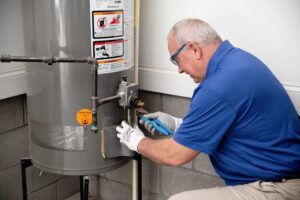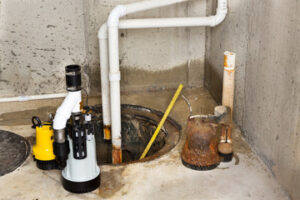Aurora CO Water Heater Repair are important appliances used to sanitize dishes, wash clothes, and provide hot shower water. The peak hour demand of your household usually sizes water heaters.
Peak hour demand is calculated by counting the number of occupants in your household and multiplying it by 12. A typical water heater has an EnergyGuide label, which lists its first-hour rating.

A water heater thermostat controls the temperature of the hot water. It does this by sending an electrical current to the heating elements, which are located inside the tank. The thermostat also detects when the water reaches the desired temperature. This prevents the elements from constantly operating, which can save energy and reduce utility costs. A programmable thermostat can also schedule heating cycles during off-peak hours.
The thermostat is located beneath the cover plate of the tank and has a dial to indicate its setting. This can be adjusted to suit your needs, but it is a good idea to keep the temperature below 140 degrees Fahrenheit because this will prevent water from being scalded. If your house has long, uninsulated pipes, raise the temperature above 120 degrees Fahrenheit to compensate for lost heat.
Most modern water heaters are tank types, which consist of insulated tanks that can hold between 20 to 80 gallons. These can be powered by electricity, natural gas, propane, or fuel oil. Most household use is with electric tank-type units, but gas heaters are also available.
These tanks are fed by a dip tube that provides cold water from the home’s plumbing to the bottom of the tank. The thermostat monitors the temperature of the water, and when it drops below a pre-set level, the heating mechanism — either an element or burner — kicks in to heat the water.
If the thermostats are faulty, it may be time to replace them. To do this, first shut off the power supply to the unit. Then, find the access panel, which is usually covered with insulation. Remove the insulation, and then unscrew the thermostat screws. Once the new thermostat is in place, turn the power supply back on.
A conventional tank-style water heater has a metal outer shell that encases a pressure-tested glass or plastic liner with a heating mechanism inside. Its capacity varies, but it usually holds 40 to 60 gallons (151 to 227 liters). The fuel source is also important, as natural gas, propane, or fuel oil are common. Some tank models have a built-in solar or geothermal energy system for greener choices.
The hot water supply pipe enters the tank through a dip tube at the bottom. Once the water is heated, it’s displaced and rises to the top of the tank. The hot water is then sent into the home’s plumbing systems.
A metal flue running through the center of the tank serves two purposes: it exhausts combustion gases and helps heat the water. There are specific code requirements for constructing the flue, and it must be properly vented outside.
In addition to the water supply and drain valves, the tank has a safety valve that vents pressure and vapor. It’s also fitted with a thermocouple to sense if the heating element burns out or the temperature is unsafe.
Inspect the tank for rust, dents, or leaks regularly. If your water heater starts leaking, shut off the fuel or cold water supply and call in a professional for a repair. A professional can also help you determine if your water heater is the right size for your household. This involves measuring your peak hour usage to calculate your Family Heat Rate (FHR). In some cases, it might be better to have a smaller tank rather than a larger one. This is especially true if your household uses energy-efficient appliances and takes shorter showers.
A drain valve allows air to exit the tank, removing collected condensate. It consists of a stem that runs parallel to the body’s hollow section and can be lowered or raised to open or close the passage. The stem of certain drain valve designs prevents flow, while the stem of others raises or lowers a flow-blocking gate in the shape of a disk or ball. Many variations on these basic models can accommodate different levels of fluid service and operational needs.
Water heater tanks collect contaminants such as calcium, other mineral sediments, and dirt in their bottom. These substances reduce the tank’s heating efficiency and can damage components. To keep them operating at full capacity, these contaminants must be removed from the tank regularly.
To empty the tank, you must shut off your water valve and drain it through its drain valve. You’ll also need a bucket and towels to catch the water that will be pouring out. It would be best to shut off the power to your tank before beginning work.
To open the drain via:
- Locate the coupling nut positioned underneath the regulator valve side of your ta
- k. Use an adjustable spanner to rotate the nut in a counterclockwise direction. Once it’s open, you can remove the nozzle and attach a hose to the drain valve
- Place the hose in a bucket to help speed up the draining process.
s.
The temperature and pressure relief valve is an essential safety feature of your water heater. When the tank becomes too hot or pressurized, this valve is designed to open and release the excess water into a discharge pipe. This protects the water heater from bursting, which can cause serious property damage and injury.
The water heater’s pressure valve is located at the top of the water tank. It has a metal lever that can be opened or closed manually and a discharge tube that runs down to a safe spot for the water to discharge. The water heater’s owner’s manual should specify the steps to open the pressure valve. It’s a good idea to wear closed-toed shoes when doing this to reduce scalding risks.
You should also make sure that the discharge tube is a safe distance from the water heater and is not obstructed by any objects. The discharge pipe should run to a bucket or a drain to catch the discharged water. It should be 1.5″ off the floor and be made of copper, CPVC, or galvanized steel water piping.
The pressure valve should be tested by opening it at least once a year. This ensures that the waterways are clear and that the valve is working properly. If you suspect that the water pressure valve is leaking or not functioning, it’s best to call in a professional to replace it.
The anode rod is a steel core wire surrounded with aluminum, magnesium, or zinc that screws into the top of your water heater. Often referred to as the “sacrificial rod,” the anode rod is meant to draw the corrosion process away from your tank’s steel lining and toward itself, protecting the more expensive steel components in your water heater.
You can replace your anode rod by purchasing a new one at your local hardware store. The choice of material depends on the chemistry of your water. For example, magnesium is typically used for most homes with hard water because it “gives up” electrons faster than aluminum, protecting the more expensive carbon steel tank lining from rust.
If you live in a soft water area, use an aluminum anode rod because it erodes more slowly. It would be best if you replaced your anode rod every three years or so, depending on the water chemistry in your area.
The longer your anode rod lasts, the less likely you are to call a plumber to repair or replace your water heater. If you have a rotten egg smell, the air in your lines, or your hot water seems choppy, your anode rod may need to be replaced.
Unless your water heater has a dedicated hole for the anode rod, it will be close to the flex line that attaches to the hot water outlet. The rod is usually labeled on the unit and locked into place with a hex nut. Once the hex nut is loose (which you can do with a crescent wrench, channel locks, or a socket wrench), you can pull out the rod and inspect it for signs of deterioration.

